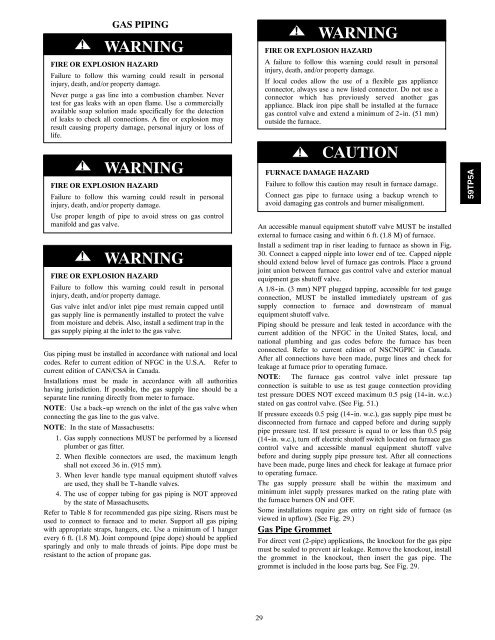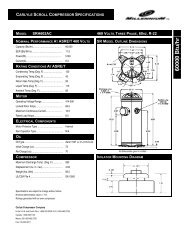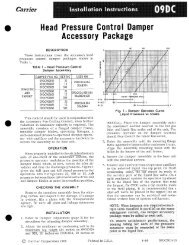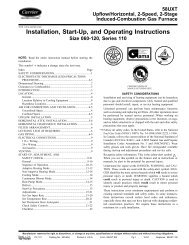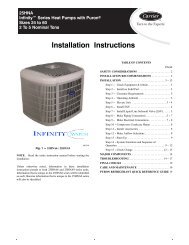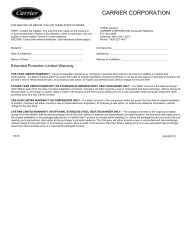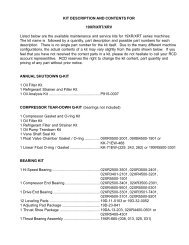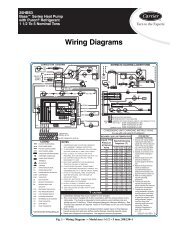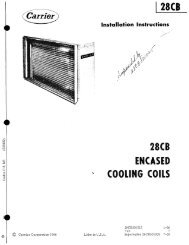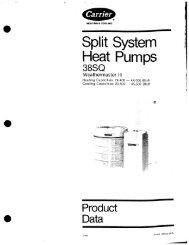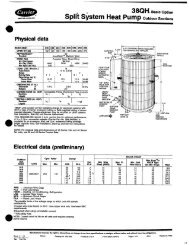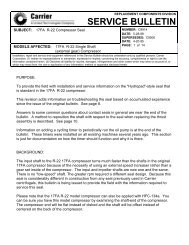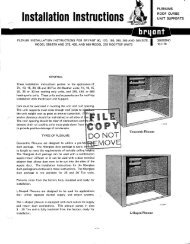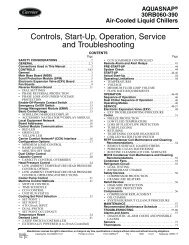warning - Docs.hvacpartners.com
warning - Docs.hvacpartners.com
warning - Docs.hvacpartners.com
You also want an ePaper? Increase the reach of your titles
YUMPU automatically turns print PDFs into web optimized ePapers that Google loves.
GAS PIPING! WARNINGFIRE OR EXPLOSION HAZARDFailure to follow this <strong>warning</strong> could result in personalinjury, death, and/or property damage.Never purge a gas line into a <strong>com</strong>bustion chamber. Nevertest for gas leaks with an open flame. Use a <strong>com</strong>merciallyavailable soap solution made specifically for the detectionof leaks to check all connections. A fire or explosion mayresult causing property damage, personal injury or loss oflife.! WARNINGFIRE OR EXPLOSION HAZARDFailure to follow this <strong>warning</strong> could result in personalinjury, death, and/or property damage.Use proper length of pipe to avoid stress on gas controlmanifold and gas valve.! WARNINGFIRE OR EXPLOSION HAZARDFailure to follow this <strong>warning</strong> could result in personalinjury, death, and/or property damage.Gas valve inlet and/or inlet pipe must remain capped untilgas supply line is permanently installed to protect the valvefrom moisture and debris. Also, install a sediment trap in thegas supply piping at the inlet to the gas valve.Gas piping must be installed in accordance with national and localcodes. Refer to current edition of NFGC in the U.S.A. Refer tocurrent edition of CAN/CSA in Canada.Installations must be made in accordance with all authoritieshaving jurisdiction. If possible, the gas supply line should be aseparate line running directly from meter to furnace.NOTE: Use a back -up wrench on the inlet of the gas valve whenconnecting the gas line to the gas valve.NOTE: In the state of Massachusetts:1. Gas supply connections MUST be performed by a licensedplumber or gas fitter.2. When flexible connectors are used, the maximum lengthshall not exceed 36 in. (915 mm).3. When lever handle type manual equipment shutoff valvesare used, they shall be T -handle valves.4. The use of copper tubing for gas piping is NOT approvedby the state of Massachusetts.Refer to Table 8 for re<strong>com</strong>mended gas pipe sizing. Risers must beused to connect to furnace and to meter. Support all gas pipingwith appropriate straps, hangers, etc. Use a minimum of 1 hangerevery 6 ft. (1.8 M). Joint <strong>com</strong>pound (pipe dope) should be appliedsparingly and only to male threads of joints. Pipe dope must beresistant to the action of propane gas.! WARNINGFIRE OR EXPLOSION HAZARDA failure to follow this <strong>warning</strong> could result in personalinjury, death, and/or property damage.If local codes allow the use of a flexible gas applianceconnector, always use a new listed connector. Do not use aconnector which has previously served another gasappliance. Black iron pipe shall be installed at the furnacegas control valve and extend a minimum of 2 -in. (51 mm)outside the furnace.!CAUTIONFURNACE DAMAGE HAZARDFailure to follow this caution may result in furnace damage.Connect gas pipe to furnace using a backup wrench toavoid damaging gas controls and burner misalignment.An accessible manual equipment shutoff valve MUST be installedexternal to furnace casing and within 6 ft. (1.8 M) of furnace.Install a sediment trap in riser leading to furnace as shown in Fig.30. Connect a capped nipple into lower end of tee. Capped nippleshould extend below level of furnace gas controls. Place a groundjoint union between furnace gas control valve and exterior manualequipment gas shutoff valve.A 1/8 -in. (3 mm) NPT plugged tapping, accessible for test gaugeconnection, MUST be installed immediately upstream of gassupply connection to furnace and downstream of manualequipment shutoff valve.Piping should be pressure and leak tested in accordance with thecurrent addition of the NFGC in the United States, local, andnational plumbing and gas codes before the furnace has beenconnected. Refer to current edition of NSCNGPIC in Canada.After all connections have been made, purge lines and check forleakage at furnace prior to operating furnace.NOTE: The furnace gas control valve inlet pressure tapconnection is suitable to use as test gauge connection providingtest pressure DOES NOT exceed maximum 0.5 psig (14 -in. w.c.)stated on gas control valve. (See Fig. 51.)If pressure exceeds 0.5 psig (14 -in. w.c.), gas supply pipe must bedisconnected from furnace and capped before and during supplypipe pressure test. If test pressure is equal to or less than 0.5 psig(14 -in. w.c.), turn off electric shutoff switch located on furnace gascontrol valve and accessible manual equipment shutoff valvebefore and during supply pipe pressure test. After all connectionshave been made, purge lines and check for leakage at furnace priorto operating furnace.The gas supply pressure shall be within the maximum andminimum inlet supply pressures marked on the rating plate withthe furnace burners ON and OFF.Some installations require gas entry on right side of furnace (asviewed in upflow). (See Fig. 29.)Gas Pipe GrommetFor direct vent (2-pipe) applications, the knockout for the gas pipemust be sealed to prevent air leakage. Remove the knockout, installthe grommet in the knockout, then insert the gas pipe. Thegrommet is included in the loose parts bag. See Fig. 29.59TP5A29


